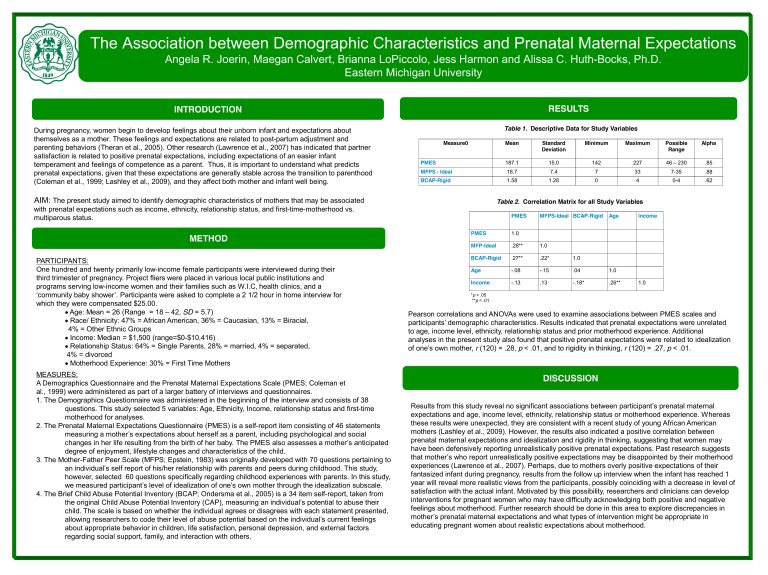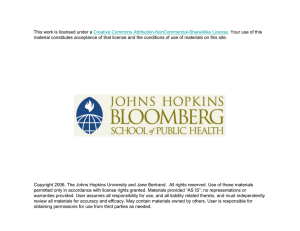The Association between Demographic Characteristics and Prenatal Maternal Expectations

The Association between Demographic Characteristics and Prenatal Maternal Expectations
Angela R. Joerin, Maegan Calvert, Brianna LoPiccolo, Jess Harmon and Alissa C. Huth-Bocks, Ph.D.
Eastern Michigan University
INTRODUCTION
During pregnancy, women begin to develop feelings about their unborn infant and expectations about themselves as a mother. These feelings and expectations are related to post-partum adjustment and parenting behaviors (Theran et al., 2005). Other research (Lawrence et al., 2007) has indicated that partner satisfaction is related to positive prenatal expectations, including expectations of an easier infant temperament and feelings of competence as a parent. Thus, it is important to understand what predicts prenatal expectations, given that these expectations are generally stable across the transition to parenthood
(Coleman et al., 1999; Lashley et al., 2009), and they affect both mother and infant well being.
AIM: The present study aimed to identify demographic characteristics of mothers that may be associated with prenatal expectations such as income, ethnicity, relationship status, and first-time-motherhood vs. multiparous status.
METHOD
PARTICIPANTS:
One hundred and twenty primarily low-income female participants were interviewed during their third trimester of pregnancy. Project fliers were placed in various local public institutions and programs serving low-income women and their families such as W.I.C, health clinics, and a
‘community baby shower’. Participants were asked to complete a 2 1/2 hour in home interview for which they were compensated $25.00.
Age: Mean = 26 (Range = 18 – 42, SD = 5.7)
Race/ Ethnicity: 47% = African American, 36% = Caucasian, 13% = Biracial,
4% = Other Ethnic Groups
Income: Median = $1,500 (range=$0-$10,416)
Relationship Status: 64% = Single Parents, 28% = married, 4% = separated,
4% = divorced
Motherhood Experience: 30% = First Time Mothers
MEASURES:
A Demographics Questionnaire and the Prenatal Maternal Expectations Scale (PMES; Coleman et al., 1999) were administered as part of a larger battery of interviews and questionnaires.
1. The Demographics Questionnaire was administered in the beginning of the interview and consists of 38 questions. This study selected 5 variables: Age, Ethnicity, Income, relationship status and first-time motherhood for analyses.
2. The Prenatal Maternal Expectations Questionnaire (PMES) is a self-report item consisting of 46 statements measuring a mother’s expectations about herself as a parent, including psychological and social changes in her life resulting from the birth of her baby. The PMES also assesses a mother’s anticipated degree of enjoyment, lifestyle changes and characteristics of the child.
3. The Mother-Father Peer Scale (MFPS; Epstein, 1983) was originally developed with 70 questions pertaining to an individual’s self report of his/her relationship with parents and peers during childhood. This study, however, selected 60 questions specifically regarding childhood experiences with parents. In this study, we measured participant’s level of idealization of one’s own mother through the idealization subscale.
4. The Brief Child Abuse Potential Inventory (BCAP; Ondersma et al., 2005) is a 34 item self-report, taken from the original Child Abuse Potential Inventory (CAP), measuring an individual’s potential to abuse their child. The scale is based on whether the individual agrees or disagrees with each statement presented, allowing researchers to code their level of abuse potential based on the individual’s current feelings about appropriate behavior in children, life satisfaction, personal depression, and external factors regarding social support, family, and interaction with others.
Measure0
PMES
MFPS - Ideal
BCAP-Rigid
RESULTS
Table 1. Descriptive Data for Study Variables
Mean Minimum Maximum
187.1
18.7
1.58
Standard
Deviation
15.0
7.4
1.28
142
7
0
227
33
4
Possible
Range
46
–
230
7-35
0-4
Alpha
.85
.88
.62
Table 2. Correlation Matrix for all Study Variables
PMES MFPS-Ideal BCAP-Rigid Age Income
PMES
1.0
MFP-Ideal
.28**
BCAP-Rigid
.27**
Age
Income
-.08
-.13
* p < .05
** p < .01
1.0
.22*
-.15
.13
1.0
.04
-.18*
1.0
.26** 1.0
Pearson correlations and ANOVAs were used to examine associations between PMES scales and participants’ demographic characteristics. Results indicated that prenatal expectations were unrelated to age, income level, ethnicity, relationship status and prior motherhood experience. Additional analyses in the present study also found that positive prenatal expectations were related to idealization of one’s own mother, r (120) = .28, p < .01, and to rigidity in thinking, r (120) = .27, p < .01.
DISCUSSION
Results from this study reveal no significant associations between participant’s prenatal maternal expectations and age, income level, ethnicity, relationship status or motherhood experience. Whereas these results were unexpected, they are consistent with a recent study of young African American mothers (Lashley et al., 2009). However, the results also indicated a positive correlation between prenatal maternal expectations and idealization and rigidity in thinking, suggesting that women may have been defensively reporting unrealistically positive prenatal expectations. Past research suggests that mother’s who report unrealistically positive expectations may be disappointed by their motherhood experiences (Lawrence et al., 2007). Perhaps, due to mothers overly positive expectations of their fantasized infant during pregnancy, results from the follow up interview when the infant has reached 1 year will reveal more realistic views from the participants, possibly coinciding with a decrease in level of satisfaction with the actual infant. Motivated by this possibility, researchers and clinicians can develop interventions for pregnant women who may have difficulty acknowledging both positive and negative feelings about motherhood. Further research should be done in this area to explore discrepancies in mother’s prenatal maternal expectations and what types of intervention might be appropriate in educating pregnant women about realistic expectations about motherhood.




